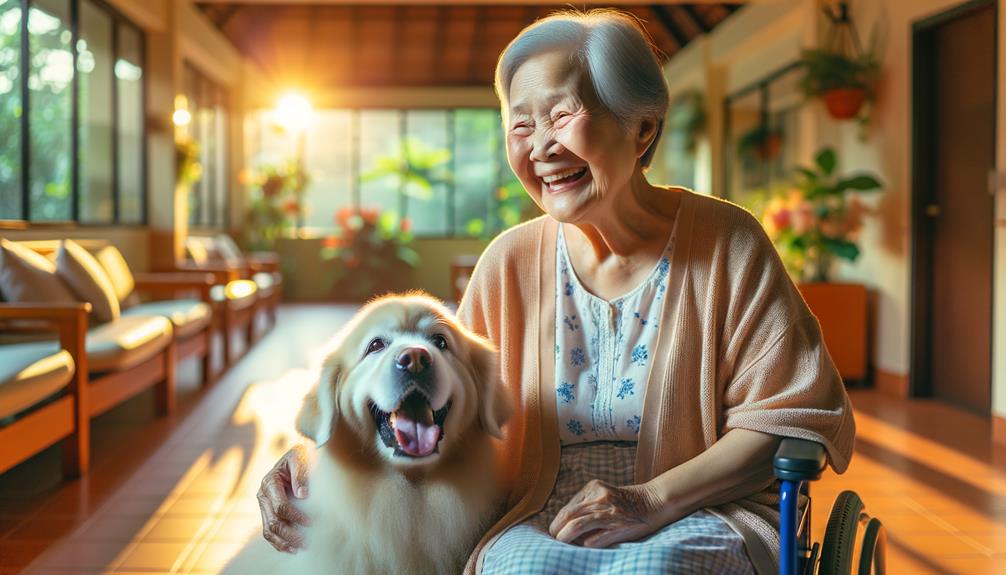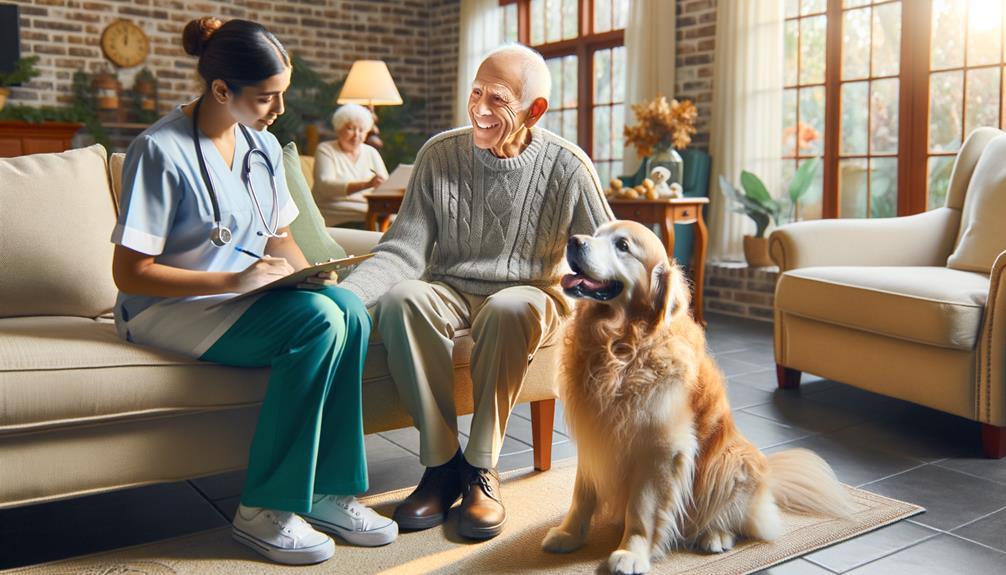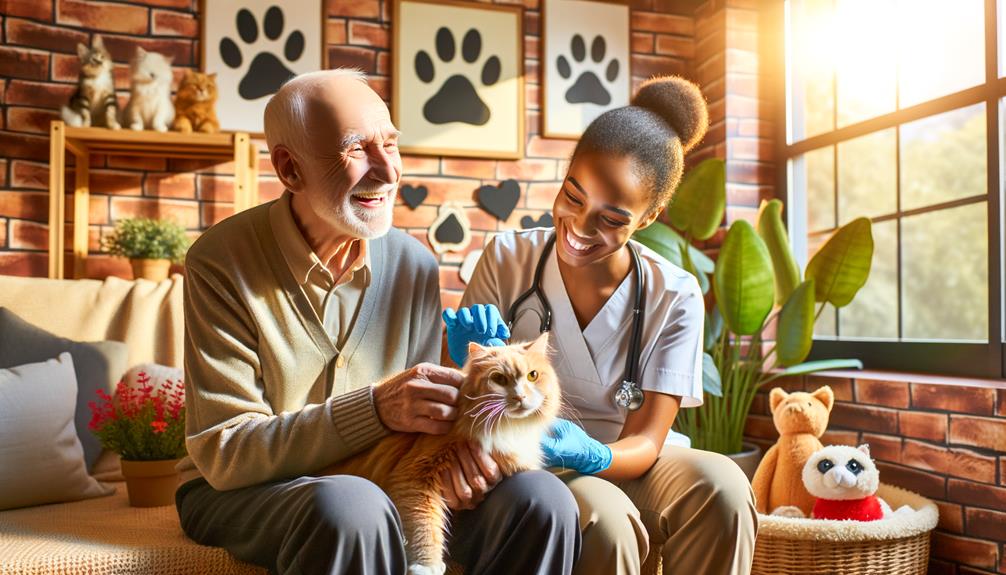Let's think about Mrs. Johnson, an 85-year-old lady who's part of our senior care facility family. She was lonely after losing her spouse, but everything changed when she met Bella, a 5-year-old Golden Retriever, through our pet therapy program. We saw her mood lift, she became more active, and her health took a turn for the better. This isn't a one-off story – there's plenty of research to back up the positive impact of pet therapy on seniors, not just emotionally, but physically too. We've seen it work wonders in our facility. But how do we get this message out to potential residents and their loved ones? And how do we make sure we're providing this therapy in the best possible way? Let's discuss this.
To make the story of pet therapy compelling, we need to keep it real. We must show them how it has improved the quality of life for our residents, like Mrs. Johnson. We need to point out the emotional and physical benefits, backed by studies and real-life examples. It's all about showing, not just telling, the difference pet therapy can make.
But how do we ensure our pet therapy program is the best it can be? It starts by listening to our residents and their needs. We need to learn what works and what doesn't, and adapt accordingly. We must provide a safe, nurturing environment for both the residents and the animals involved.
Remember, the goal here is to provide the best care for our seniors. And if pet therapy can help us achieve that, then it's worth every effort to ensure it's done right, and to let everyone know about it.
Understanding Pet Therapy

Understanding the power of pet therapy requires recognizing its significant contribution to the improvement of seniors' lives. Pets offer not just companionship and emotional support, but also a wide range of other holistic benefits. Therapy animals, who are friendly and well-trained, mingle with seniors to ease their feelings of loneliness and provide emotional comfort. This shows the deep-seated benefits of pet therapy.
In our bid to provide all-round care for seniors, the role of pet therapy cannot be ignored. It can take place in diverse environments such as having a pet, pet visitation programs, and animal-assisted therapy. These can be tailored to suit the individual needs and situations of seniors, making it a flexible and efficient method.
Pet therapy, however, is not just about companionship. It offers real health benefits too. It keeps the mind active and gives seniors a sense of responsibility as they take care of their pets. This interaction breaks the dull routine and isolation that seniors often face, filling their lives with purpose and happiness.
In understanding pet therapy, we acknowledge its part in reducing loneliness, bettering emotional health, and keeping the mind active among seniors. As we aim to help others, it's important to champion pet therapy in senior care, aiming for an improved quality of life for our beloved seniors.
Benefits of Pet Therapy for Seniors

Let's chat about pet therapy and how it can be a game-changer for seniors. It's a well-known fact that having a pet around can do wonders for one's emotional health. For the elderly, this can be a huge help in tackling feelings of being alone or cut off from the world. Interacting with animals breathes fresh air into their routine, introducing happiness and a new enthusiasm for life.
But there's more to it than just emotional support. Pet therapy has been shown to work wonders on physical health too. Regular playtime with pets can help improve heart health and keep seniors moving. This is a great way to illustrate just how powerful this type of therapy can be.
Pet therapy isn't just about having a cuddly companion around. It's actually a well-thought-out approach to caring for seniors. Research shows it can help improve memory and cognitive function in people suffering from dementia. So, as we work tirelessly to improve the lives of our elderly, adding pet therapy to our care plans can turn out to be extremely beneficial. Let's appreciate pet therapy for all it has to offer to seniors, and approach their care in a more humane and wholehearted manner.
Implementing Pet Therapy in Senior Care

In our continuous effort to improve senior care, we've come across a unique method that's proving to be beneficial for the well-being of our elderly loved ones – pet therapy. This involves more than just having pets around in assisted living facilities. The goal is to create meaningful experiences that boost the overall health and spirits of our seniors.
Here's our plan to integrate pet therapy in the daily lives of seniors:
- We plan to introduce different types of pet therapy, including the options of owning pets, pet visitation, and animal-assisted therapy.
- Expanding the variety of animals involved in the therapy, which could range from dogs and cats to horses and farm animals.
- Each therapy session will be designed to cater to the specific needs and tastes of our seniors.
- We'll track and assess the impact of pet therapy on the physical and emotional health of seniors.
This form of therapy offers an array of benefits for seniors. From reducing stress, loneliness, and depression to improving cardiovascular health, increasing social interaction, and promoting mobility – pet therapy has it all. By bringing pet therapy into our program, we're not just enriching the lives of our seniors; we're also setting a precedent in senior care.
Challenges and Solutions in Pet Therapy

The idea of using pet therapy in eldercare is really exciting for us. But it's important to talk about the hurdles we might come across and how we can overcome them to make it really work.
No doubt, pet therapy can make life better for older folks, particularly those who might feel alone. But we can't forget about all the things we need to think about when it comes to looking after the pets in these therapy sessions and for seniors who are still on the go.
Let's take a quick look at some of the problems and solutions tied to pet therapy:
| Problem | Fix | How it Helps Seniors |
|---|---|---|
| Looking after pets | Teaching seniors | More involvement |
| Movement troubles | Activities that adapt | Better fitness |
| Picking the right pets | Serious pet training | Safer meet-ups |
When you're thinking about starting pet therapy in a care home, you can't forget about allergies or past experiences with pets. Making sure the pet therapy sessions are designed for each person's needs helps get the most out of it and makes life better for seniors.
Remember, often it's the simple language that gets the message across best. If something sounds too complicated, try breaking it down or swapping fancy words for more straightforward ones. Make sure your language reflects what's happening now and how people talk. Avoid old or overly technical language unless it's really needed for the topic.
Don't rely on the same old phrases and words. It's better to avoid them. Instead, try to come up with new ways of saying things or be straightforward with your descriptions. Instead of using the same old transition words or phrases, aim for a natural flow in your writing. Transitions based on the content can often work better.
Avoid using exaggerated language to make your point, it can take away from the credibility of the article. Stick to the facts and back up what you're saying with evidence where you can.
Always remember who you're writing for. Change your language to fit what your readers know and understand. An active voice can make your writing clearer and more direct. Go for this over a passive voice whenever you can.
Instead of just saying that something is 'important' or 'essential,' explain why it matters. This gives the reader a better understanding and makes the content more interesting.
Marketing Strategies for Pet Therapy

Let's chat about how we can effectively get the word out about pet therapy in senior care. Focusing on the incredible value and potential of therapy pets is vital.
- Share personal stories: Let's tell the heartwarming tales of seniors who've found a friend in their pet companions. This helps us put a spotlight on the emotional perks such as companionship and love that therapy pets bring.
- Pair up with healthcare practitioners: We can team up with healthcare pros to confirm the mental and physical health benefits that pet therapy provides for the elderly.
- Educational workshops: How about conducting webinars or workshops at senior living facilities? This gives us a chance to show the positive effects of pet therapy in real-time.
- Reach out to local media: Local press can be a great ally in spreading the word about the advantages of pet therapy in senior care.
When we put these marketing strategies in place, we're doing more than just advertising a service. We're offering a solution for health problems, isolation, and the need for unconditional love in the lives of our seniors. We're standing up for the improved wellbeing of our elders and for the significant difference a pet companion can make.
Frequently Asked Questions
What Are the Benefits of Animal Therapy for Older Adults?
Here's the thing about pet therapy – it does wonders for the health and well-being of older adults. You see, studies have shown that spending time with animals can significantly boost cardiovascular health and improve physical mobility in seniors. But that's not all. This type of therapy can also alleviate feelings of anxiety and loneliness. Plus, it encourages social interaction and gives seniors a meaningful role to play. All in all, incorporating animals into elderly care can bring about some pretty incredible changes.
How Can Pets Help the Elderly?
You know, it's truly amazing how much pets can do for older folks. They offer a sense of companionship that can really make a difference in their lives. Not only that, but they also help in relieving stress and encouraging interaction with others. It's like they have this magic power to fight off feelings of loneliness and sadness. This helps the elderly to lead a life that's not just healthier, but also filled with positivity. It's pretty cool, right?
Why Is Pet Therapy Good for Dementia?
Isn't it remarkable how pet therapy can uplift the spirits of those living with dementia? The benefits are truly noteworthy. When these individuals engage with animals, it's like a breath of fresh air is injected into their lives. It's not just about the joy of having a cuddly creature around. There's more to it.
These interactions can lessen negative attitudes and behaviors, which is a big win in our books. But that's not all. It also stirs up memories, and we all know how precious those are for folks grappling with dementia. And let's not forget the soothing company these pets provide. It's like they bring a whole new meaning to life for our older adults, and that's something we can all get behind.
What Is the Main Goal of Animal-Assisted Therapy?
You know, the main aim of therapy involving animals is all about improving a person's health – physically, emotionally, and mentally. It's about fostering a friendship with trained animals, cutting down on feelings of isolation, and offering a sense of purpose. It's amazing how much a connection with an animal can help, isn't it?




